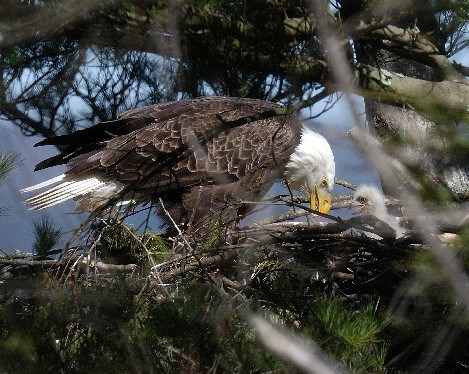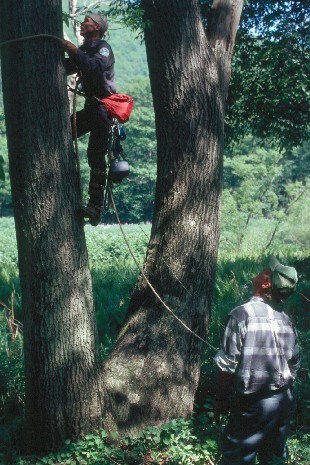|
More than 100 eagles migrate to the Upper Delaware each winter in search of open water, fresh and abundant fish and undisturbed habitat. When lakes and rivers freeze over in northern portions of the United States and Canada, bald eagles move southward to areas like the Upper Delaware river valley. It's estimated that at least 200 different eagles use the Delaware River for some period of time during the winter months. Depending on weather conditions, the eagles begin arriving in mid-December. By mid-March most eagles begin the return flight to their breeding areas located to the north. Though each year we find that there are more and more year round "resident" eagles staying in the Upper Delaware, building their nests and raising their young.

Scott Rando Life History of Bald EaglesBald eagles primarily eat fish. As a result, they typically build nests near water. However, if food is scarce, they are opportunistic feeders and will eat birds, small mammals, and carrion (dead animals). 
E. Rozanski / NPS Characteristics of Bald EaglesThe bald eagle is one of the largest birds in the Northeast. In profile, as it flies toward you, its wings are held straight out; the more common turkey vulture soars with its wings held in a V-shape. As the eagle passes overhead, the feathers at the tips of its wings are widely separated, and its relatively short tail is usually fanned open.

J. Leung / NPS 
J. Leung / NPS 
J. Leung / NPS 
NPS Bald Eagle ConservationUntil recently, your chances of actually seeing an eagle along the Upper Delaware were slim. That has changed, thanks to recent cooperative efforts to improve environmental conditions and to re-establish the bald eagle in the eastern United States.
The banning of DDT in 1972 and the implementation of new laws prohibiting the killing and injuring of eagles was a major step in helping restore bald eagle populations. Regionally, the Upper Delaware River has played an important role in this population growth. Both the New York State Department of Environmental Conservation (NYDEC) and Pennsylvania Game Commission created bald eagle restoration ("hacking") programs to increase bald eagle populations in their states. Reporting Injured or Harassed EaglesNY Department of Environmental Conservation Wildlife Diversity Unit518-402-8883 Pennsylvania Game Commission Centralized Dispatch1-833-742-9453 (1-833-PGC-WILD) Discover Eagle Watching at Upper DelawareWith proper technique and planning, winter eagle-watching has become a popular off-season activity in the Upper Delaware Valley.The Delaware Highlands Conservancy works cooperatively with the National Park Service and with New York State Department of Environmental Conservation to help visitors find and properly observe wintering eagles along the Upper Delaware River. The Upper Delaware River offers several eagle viewing spots where creeks and other rivers meet the Delaware. 
Eagle Watching at Upper Delaware
Learn about how and where to watch eagles in the Upper Delaware River Valley. 
Recommended Eagle Watching Locations
Interested in seeing our national bird? Explore different popular eagle viewing locations around the Upper Delaware River Valley. Learn More
|
Last updated: March 26, 2025



